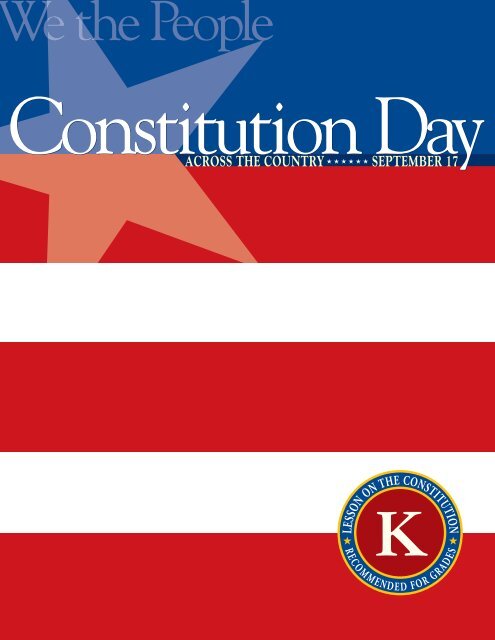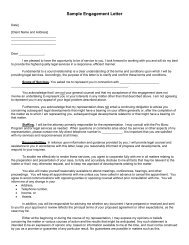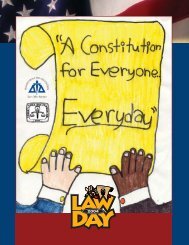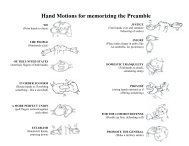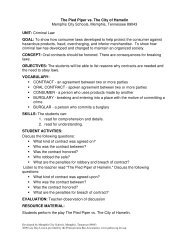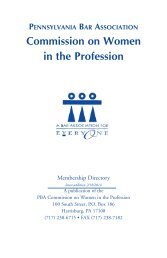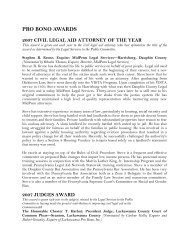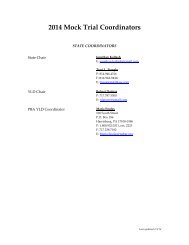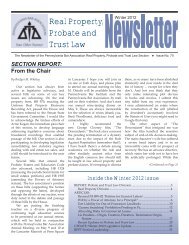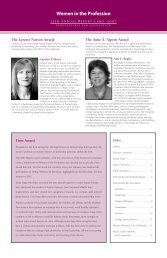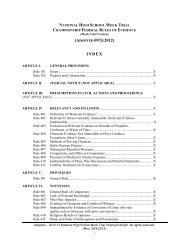You also want an ePaper? Increase the reach of your titles
YUMPU automatically turns print PDFs into web optimized ePapers that Google loves.
<strong>About</strong> Constitution Day<br />
★ ★ ★ ★ ★ ★ ★ ★ ★ ★ ★ ★ ★ ★ ★ ★ ★ ★ ★ ★<br />
In 1952, President Harry S. Truman signed a bill that<br />
moved “I Am an American Day” from the third Sunday in<br />
May to September 17 so that this holiday would coincide<br />
with the signing of the U.S. Constitution in 1787. Congress<br />
renamed the holiday “Citizenship Day.” A joint resolution<br />
passed in 1956 requested the President to proclaim the<br />
week beginning September 17 <strong>and</strong> ending September 23<br />
each year as “Constitution Week.”<br />
Senator Robert C. Byrd (D-WV) entered an amendment to<br />
the Consolidated Appropriations Act of 2005 that changed<br />
the name of the September 17 holiday to “Constitution<br />
Day <strong>and</strong> Citizenship Day.” The purpose of “Constitution<br />
Day <strong>and</strong> Citizenship Day” is to honor <strong>and</strong> celebrate the<br />
privileges <strong>and</strong> responsibilities of U.S. citizenship for both<br />
native-born <strong>and</strong> naturalized citizens, while commemorating<br />
the creation <strong>and</strong> signing of the supreme law of our l<strong>and</strong>.<br />
The addition of the amendment, known as Public Law<br />
108-477, requires all schools that receive federal funds hold<br />
an educational program for their students on September 17<br />
of each year. This lesson, which is adapted from curricular<br />
materials on the Constitution produced by the Center for<br />
Civic Education, is designed to assist schools <strong>and</strong> federal<br />
agencies to meet the requirements of this law.
<strong>Orb</strong> <strong>and</strong> <strong>Effy</strong><br />
<strong>Learn</strong> <strong>About</strong><br />
<strong>Authority</strong>
Bubble L<strong>and</strong><br />
Close your eyes. Can you see a big, round bubble?<br />
Gently, it floats through the air. Quietly, up <strong>and</strong> up it<br />
goes. The light makes the bubble shiny <strong>and</strong> colorful.<br />
Our story is about a bubble. We call it Bubble L<strong>and</strong>. It is<br />
also about the people who we imagine live in Bubble L<strong>and</strong>.<br />
The sky in Bubble L<strong>and</strong> is bright. It makes you<br />
think of a rainbow. The l<strong>and</strong> <strong>and</strong> the houses are blue,<br />
green, <strong>and</strong> sometimes red. If you blow a soap bubble<br />
you will see many of the same colors. The Bubble<br />
People are all different colors, too.<br />
Meet <strong>Orb</strong>. He is big <strong>and</strong> round. Everyone knows <strong>Orb</strong>.<br />
He has a blue beard. <strong>Orb</strong> owns an ancient bubble pipe<br />
1
made of clay. <strong>Orb</strong> blows bubbles from this pipe everywhere<br />
he goes.<br />
<strong>Orb</strong> says, “A long time ago children blew bubbles from<br />
clay pipes just like the one I own. It makes me happy to<br />
blow bubbles from this pipe like in the old days.”<br />
Meet <strong>Effy</strong>. She has a big smile. Her name is <strong>Effy</strong> because<br />
she is always effervescent, that means bubbly. <strong>Effy</strong> <strong>and</strong><br />
<strong>Orb</strong> have been friends forever. Everyone trusts <strong>Effy</strong>.<br />
She always tells the truth. People want to hear what<br />
she has to say.<br />
“Today Bubble L<strong>and</strong> is a happy place. The Bubble<br />
People think it is a good place to be,” <strong>Effy</strong> said.<br />
2
“Bubble L<strong>and</strong> was not always this way. A long time<br />
ago, we were in great danger. Our bubble walls got<br />
thinner <strong>and</strong> thinner. The colors of the sky grew dimmer<br />
<strong>and</strong> dimmer. The air became cooler <strong>and</strong> cooler. Smoke<br />
from the factories filled our bubble. It got dirtier <strong>and</strong><br />
dirtier. The light did not shine inside. And Bubble L<strong>and</strong><br />
started to sink. Down <strong>and</strong> down it went,” said <strong>Orb</strong>.<br />
“The problem was the way we lived,” said <strong>Effy</strong>. “Bubble<br />
People love ice cream, <strong>and</strong> cake, <strong>and</strong> c<strong>and</strong>y. Day <strong>and</strong><br />
night the factories made sweets for us to eat.”<br />
“Another problem was the way we acted,” <strong>Orb</strong> reminded<br />
<strong>Effy</strong>. “People did whatever they pleased. Some people<br />
took things without asking. Some people tried to eat<br />
all the food. No one wanted to share. People disagreed<br />
about everything.”<br />
3
“We knew what was happening to Bubble L<strong>and</strong>,” <strong>Effy</strong><br />
said. “We were very scared!”<br />
DISCUSSION POINT 1<br />
“Some Bubble People had good ideas about how to save<br />
Bubble L<strong>and</strong>,” <strong>Orb</strong> continued. “But no one could agree<br />
on what to do. People became angry <strong>and</strong> started to argue.<br />
They could only agree to disagree.”<br />
DISCUSSION POINT 2<br />
“<strong>Orb</strong>, remember how we looked <strong>and</strong> looked for the Bubble<br />
L<strong>and</strong> rules, but we could not find any? We had no rules!<br />
We had nothing to help us solve our problems!” said <strong>Effy</strong>.<br />
“That’s right,” <strong>Orb</strong> replied. “There were no leaders in<br />
Bubble L<strong>and</strong>. There was no one to tell us what to do.<br />
There was no one to help us settle arguments or to<br />
help us agree.”<br />
Meet Purl. She recalls the old days in Bubble L<strong>and</strong>,<br />
too. “In every house people talked about the terrible<br />
4
problem. My neighbor said that we should have rules.<br />
Rules might help solve the problem.”<br />
“I remember that,” <strong>Orb</strong> replied. “People were angry.<br />
‘WHY DO WE NEED RULES?’ they shouted.”<br />
“I thought we needed leaders,” Purl said.<br />
“People were angry about that, too,” <strong>Effy</strong> recalled.<br />
“ ‘WHY DO WE NEED LEADERS?’ the people shouted.”<br />
The people shouted <strong>and</strong> argued but they did not do<br />
anything. Meanwhile, Bubble L<strong>and</strong> sank lower <strong>and</strong> lower.<br />
“What can we do?” worried the Bubble People.<br />
DISCUSSION POINT 3<br />
Then one day, <strong>Effy</strong> said to <strong>Orb</strong>, “We must do something<br />
or it will be too late! Let’s call all the people of Bubble<br />
L<strong>and</strong> to a meeting.”<br />
“On the day of the meeting, everyone talked at once,”<br />
<strong>Effy</strong> recalls. “It was noisy. Hardly anyone could hear.<br />
5
Then <strong>Orb</strong> got up to speak.”<br />
“Quiet! Quiet, please!” <strong>Orb</strong> shouted to the crowd.<br />
Slowly the crowd grew quieter. Then, all the Bubbles<br />
were ready to listen.<br />
“Let’s try to speak one at a time,” <strong>Orb</strong> said to the crowd.<br />
“<strong>Effy</strong>, you may speak first.”<br />
“There is one thing I know,” <strong>Effy</strong> told the people.<br />
“We must solve this problem. We have to agree to<br />
work together to put Bubble L<strong>and</strong> high in the air<br />
again. We need some rules. We also need rules<br />
to help us get along better, so we can solve our<br />
problems together.”<br />
After much whispering, everyone at the meeting agreed.<br />
Bubble L<strong>and</strong> needed good rules <strong>and</strong> good leaders.<br />
DISCUSSION POINT 4<br />
6
PROBLEM-SOLVING ACTIVITY<br />
<strong>Authority</strong> vs Power without <strong>Authority</strong><br />
PARALLELS<br />
Compare to the United States <strong>and</strong> the U.S. Constitution<br />
Parallels to the United States <strong>and</strong> the U.S. Constitution<br />
Discussing the “Framers”<br />
7
INTRODUCING THE CONCEPT<br />
<strong>Authority</strong> touches the lives of everyone<br />
in society. It affects parents, teachers,<br />
children, judges, legislators, <strong>and</strong> presidents.<br />
Some people might view authority as<br />
unnecessary, even antithetical to freedom<br />
<strong>and</strong> human dignity. Most people, however,<br />
see authority as essential to civilization<br />
<strong>and</strong> valuable to social existence. Americans<br />
have always displayed a distrust of<br />
authority, while looking to authority for<br />
resolution of conflict <strong>and</strong> maintenance<br />
of order. Our Constitution clearly reflects<br />
this fundamental ambivalence. The<br />
Constitution provides for authority,<br />
but it also limits its practice.<br />
Since government is defined as people<br />
<strong>and</strong> groups with the authority to perform<br />
certain functions in a society, it is important<br />
to underst<strong>and</strong> the concept of<br />
authority <strong>and</strong> the related concept of<br />
power. An underst<strong>and</strong>ing of the difference<br />
between power <strong>and</strong> authority is essential<br />
for underst<strong>and</strong>ing whether people with<br />
power have the right to exercise it.<br />
An underst<strong>and</strong>ing of the necessity of<br />
authority <strong>and</strong> its usefulness in promoting<br />
agreed upon goals that benefit the<br />
individual <strong>and</strong> society is essential for the<br />
development of informed, competent,<br />
<strong>and</strong> responsible citizens.<br />
In the United States, the powers of<br />
government are limited. They are limited<br />
to ensure that people in positions of<br />
authority fulfill the responsibilities they<br />
have been assigned, serve the major<br />
purposes of government, <strong>and</strong> do not<br />
misuse or abuse the power they have been<br />
given. Limits on authority are seen as<br />
essential to the protection of individual<br />
rights. An underst<strong>and</strong>ing of the reasons<br />
for <strong>and</strong> the necessity of placing limits on<br />
authority is essential if citizens are to<br />
control their government <strong>and</strong> make sure<br />
that government fulfills its purpose.<br />
Imparting these ideas to very young<br />
children presents a unique challenge.<br />
The story <strong>Orb</strong> <strong>and</strong> <strong>Effy</strong> <strong>Learn</strong> <strong>About</strong><br />
<strong>Authority</strong> has four chapters. Each chapter<br />
presents material designed to teach an<br />
important aspect of the concept.<br />
• Chapter 1: What is authority?<br />
Children learn to define the concept<br />
<strong>and</strong> identify some important uses of<br />
authority in society.<br />
• Chapter 2: How can we decide if a rule<br />
is a good rule? How should we choose<br />
people to be leaders?<br />
We address two important aspects of<br />
using authority: making rules <strong>and</strong> choosing<br />
leaders. Allow time for two lessons.<br />
• Chapter 3: How can we decide if we<br />
want to use authority?<br />
Some of the consequences of using<br />
authority are benefits <strong>and</strong> some are costs.<br />
Children learn some of the most common<br />
benefits <strong>and</strong> costs. They make decisions<br />
about whether to use authority in a<br />
situation.<br />
• Chapter 4: How much authority<br />
should a leader have?<br />
Children learn that a position of<br />
8<br />
NOTES<br />
FOR THE<br />
TEACHER
authority can be abused if it is not designed<br />
with care. Positions of authority<br />
must be well designed with duties,<br />
powers, <strong>and</strong> limits clearly established.<br />
To meet the Constitution Day m<strong>and</strong>ate<br />
we have adapted Chapter 1 of the story.<br />
The characters in <strong>Orb</strong> <strong>and</strong> <strong>Effy</strong> <strong>Learn</strong> <strong>About</strong><br />
<strong>Authority</strong>, needed to create rules for their<br />
country to proceed with order <strong>and</strong> to<br />
protect its citizens, just as the Framers<br />
did. It is important for students to<br />
underst<strong>and</strong> that the Constitution is the<br />
Supreme Law of the l<strong>and</strong> <strong>and</strong> that our<br />
leaders derive the legitimate use of their<br />
power (authority) from it. After reading the<br />
story <strong>and</strong> underst<strong>and</strong>ing the basic concepts,<br />
a simple parallel is drawn between what<br />
the people of Bubble L<strong>and</strong> needed to do<br />
<strong>and</strong> what the Framers needed to do.<br />
THE LESSON GUIDE<br />
The lesson guide provides some<br />
background on the concepts that the<br />
students will learn. It will also provide<br />
discussion questions to use throughout<br />
the reading of the story <strong>and</strong> problemsolving<br />
activities. The pictures at the<br />
end of the guide are to be used while<br />
reading the story. You may choose to<br />
display them at the appropriate points<br />
in the story or mount them in the classroom<br />
all at once <strong>and</strong> then refer to<br />
each at the appropriate points.<br />
The script for the story has three types<br />
of cues:<br />
• Picture placement. Thumbnail prints in<br />
the script itself will indicate which<br />
picture is appropriate at that point in<br />
the story.<br />
• Discussion Point pauses. These marks<br />
indicate when to ask the questions that<br />
will facilitate concept development<br />
• Problem-solving points <strong>and</strong> section<br />
headings.<br />
LESSON OVERVIEW<br />
This lesson introduces the study of authority.<br />
Children learn that when people<br />
have a right to tell others what to do in<br />
certain situations, they are exercising<br />
authority. When they do not have that<br />
right, they are exercising power without<br />
authority. Children learn some ways in<br />
which people earn the right to exercise<br />
authority.<br />
The lesson also illustrates problems<br />
that are likely to arise in the absence of<br />
effective authority. Children learn how<br />
<strong>and</strong> why authority is useful in society.<br />
LESSON OBJECTIVES<br />
At the conclusion of the lesson,<br />
students should be able to<br />
1. define the term authority<br />
2. identify some important uses of<br />
authority in society<br />
3. identify the Constitution as a legitimate<br />
source of authority to organize<br />
the government <strong>and</strong> its leaders<br />
9<br />
NOTES<br />
FOR THE<br />
TEACHER
PREPARATION / MATERIALS<br />
• A copy of <strong>Orb</strong> <strong>and</strong> <strong>Effy</strong><br />
<strong>Learn</strong> <strong>About</strong> <strong>Authority</strong><br />
• Pictures of the storybook characters<br />
• The lesson guide<br />
• Paper <strong>and</strong> crayons<br />
IDEAS FOR THE TEACHER<br />
These are ideas the instructor<br />
should know <strong>and</strong> be able to<br />
explain<br />
A job can give you authority, or the<br />
right, to tell others what to do. A<br />
teacher tells you to study your lessons.<br />
That is part of a teacher’s job.<br />
The law can give you authority, or<br />
the right, to tell others what to do.<br />
A law is a rule made by people in the<br />
government. A police officer may tell<br />
you to wear a helmet when riding a<br />
bike. The law gives the officer the<br />
right to use power.<br />
Parents tell their children what to do.<br />
It is their right as parents. The law also<br />
says they have the right to use power.<br />
They have authority.<br />
Sometimes people use power but they<br />
do not have the right to do so. A bully<br />
might tell another student to leave the<br />
schoolyard. Robbers might tell someone<br />
to give them money. These people do<br />
not have the right to make anyone do<br />
these things. They use power without<br />
authority. This means using power without<br />
having the right to do so.<br />
Help the children underst<strong>and</strong> that<br />
authority is the right to exercise power.<br />
It is the right to tell others what to do.<br />
Children should learn that when a person<br />
does not have a right to tell others what<br />
to do, that person is using power without<br />
authority. It is important to know the<br />
distinction between authority <strong>and</strong> power<br />
without authority to decide if a person<br />
is using power legitimately.<br />
This lesson helps children underst<strong>and</strong><br />
that in the absence of rules or people with<br />
authority, their lives would be difficult<br />
<strong>and</strong> possibly dangerous. Children should<br />
learn that authority is important to<br />
society: the community, the school, <strong>and</strong><br />
their classroom. Designating authority<br />
serves many societal functions. Some of<br />
these help us to maintain order <strong>and</strong> safety,<br />
protect property, share things fairly, <strong>and</strong><br />
settle conflicts peaceably, while some help<br />
us to protect important rights such as<br />
the right to free expression.<br />
You probably have a rule that requires<br />
children to raise a h<strong>and</strong> before they speak<br />
out in the classroom. The rule helps<br />
you maintain order; it helps you fairly<br />
distribute time during a class discussion<br />
among those who want to speak; <strong>and</strong> it<br />
protects the right of a child to express<br />
his or her ideas.<br />
10<br />
NOTES<br />
FOR THE<br />
TEACHER
IDEAS FOR THE STUDENT<br />
Introduce the ideas that children<br />
should know<br />
Complete this exercise with the children<br />
before reading the story. Read the following<br />
aloud <strong>and</strong> discuss the questions.<br />
• • • • • • • •<br />
Many times you decide what you want<br />
to do. No one tells you to do it.<br />
• David said, “I am going to go play at<br />
Jim’s house.”<br />
• Ruth said, “I am going to feed my cat.”<br />
David <strong>and</strong> Ruth are acting on their<br />
own. No one told them what to do.<br />
Many times you do what others say you<br />
should do. Display picture.<br />
• “Amy, please brush your teeth,” said<br />
Amy’s mother.<br />
• “Luke, give me your lunch money or I<br />
will hit you,” said Al.<br />
Amy’s mother <strong>and</strong> Al each told someone<br />
what to do. Both used power.<br />
Someone has power when they tell<br />
people what to do <strong>and</strong> they do it.<br />
What is different about what Al said<br />
<strong>and</strong> what Amy’s mother said?<br />
Does Al have the right to make Luke<br />
give him money? Why?<br />
Does Amy’s mother have the right to<br />
tell Amy to brush her teeth? Why?<br />
Amy’s mother had authority. <strong>Authority</strong><br />
means to have the right to use power.<br />
It is the right to tell others what to do.<br />
Al used power without authority. He<br />
did not have the right to ask for Luke’s<br />
money. He did not have the right to<br />
threaten Luke.<br />
Ask the children:<br />
• When have you seen someone use<br />
power without authority?<br />
• When have you seen someone use<br />
authority?<br />
• Why do you want to know if someone<br />
is using authority or power without<br />
authority?<br />
READ THE STORY<br />
<strong>Orb</strong> <strong>and</strong> <strong>Effy</strong> <strong>Learn</strong> <strong>About</strong> <strong>Authority</strong><br />
Prepare the children to listen; read the<br />
story aloud. Give them a short overview<br />
of the story <strong>and</strong> show some of the<br />
illustrations.<br />
The story has several discussion points<br />
indicated. Point 1 page 4 deals with<br />
power without authority: some Bubble<br />
People take whatever they want; some eat<br />
more food than they need. Point 2 on<br />
page 4 is concerned with all the Bubble<br />
L<strong>and</strong>’s problems <strong>and</strong> looks toward a<br />
solution. Points 3 <strong>and</strong> 4 on pages 5 <strong>and</strong> 6<br />
engage students in thinking about<br />
the functions of rules <strong>and</strong> people<br />
with authority.<br />
11<br />
NOTES<br />
FOR THE<br />
TEACHER
The discussion should help children<br />
underst<strong>and</strong> what might happen in a place<br />
where there are no rules, laws, or people<br />
in positions of authority. It should help<br />
children underst<strong>and</strong> why we need<br />
authority in society.<br />
DISCUSSION POINT 1<br />
Read to Discussion Point 1 on page 4.<br />
Discuss the following questions with<br />
the children. Some possible responses<br />
are below.<br />
What problems did the<br />
Bubble People have?<br />
Bubble L<strong>and</strong> was in danger. The walls<br />
of the bubble got thinner <strong>and</strong> thinner.<br />
The colors of the sky grew dimmer <strong>and</strong><br />
dimmer. The air became cooler <strong>and</strong> cooler.<br />
The factories in Bubble L<strong>and</strong> polluted<br />
the air. The dirty air prevented the sun<br />
from entering the bubble. The cooling<br />
air was causing Bubble L<strong>and</strong> to sink.<br />
The environmental problems in Bubble<br />
L<strong>and</strong> were caused by the way the Bubble<br />
People lived. Day <strong>and</strong> night the factories<br />
manufactured c<strong>and</strong>y, ice cream, <strong>and</strong><br />
sweets. The people did whatever they<br />
pleased because there were no rules.<br />
The people did not share things. Some<br />
people ate more food than they needed.<br />
The people could not agree on anything,<br />
instead they became angry <strong>and</strong> argued.<br />
Why are these things problems?<br />
Accept any reasonable answer.<br />
DISCUSSION POINT 2<br />
Read to the Discussion Point 2 on page 4.<br />
Ask the following question:<br />
What are some things the Bubble<br />
People could do to solve these problems?<br />
Make a list of the suggestions the students<br />
offer <strong>and</strong> keep the list in sight.<br />
DISCUSSION POINT 3<br />
Read to Discussion Point 3 on page 5.<br />
<strong>and</strong> ask the following questions:<br />
What ideas did the Bubble People have<br />
that would solve their problems?<br />
Purl’s neighbor suggests that having rules<br />
might help solve the problems. But many<br />
Bubble People did not like the idea.<br />
<strong>Orb</strong> remembers that there were no leaders<br />
to tell the people what to do. When<br />
the suggestion of leaders was raised<br />
it angered people.<br />
Were any of their ideas similar to your<br />
ideas for solving the problems?<br />
Have students match the Bubble People<br />
suggestions with those on their list.<br />
DISCUSSION POINT 4<br />
Read to the Discussion Point 4 on<br />
page 6 <strong>and</strong> ask the students:<br />
Why do we need rules?<br />
Accept any reasonable answer.<br />
12<br />
NOTES<br />
FOR THE<br />
TEACHER
Explain that another word for “rule” is<br />
“law,” <strong>and</strong> that essentially what the people<br />
of Bubble L<strong>and</strong> did was to create laws.<br />
Ask students if they can think of any<br />
laws we must follow?<br />
Why do we need leaders?<br />
Accept any reasonable answer.<br />
Ask students if they can name some<br />
leaders in the community.<br />
Have you seen any problems like these?<br />
What are they?<br />
Children might state a problem at school,<br />
for example, trash in the hallways. The<br />
problem occurred because there was no<br />
rule or no person with authority to address<br />
the issue. They might give examples like<br />
sharing TV time with their siblings because<br />
there is no rule or person enforcing the<br />
rule. They might give examples in the<br />
classroom, such as a problem of sharing<br />
things because there is no rule or person<br />
to enforce the rule.<br />
PROBLEM-SOLVING<br />
Read the situations aloud to the children.<br />
Ask them to say if the person is using<br />
authority or power without authority.<br />
Following are some common responses<br />
to each of the three situations.<br />
The crossing guard said, “You may cross<br />
the street.”<br />
The crossing guard is using authority.<br />
The authority has been delegated by<br />
school authorities, who, by law must<br />
protect children on their way to <strong>and</strong> from<br />
school. The authority of the crossing<br />
guard also derives from state traffic laws.<br />
Luis said, “Let me cut in line, now!”<br />
Luis is using power without authority.<br />
He does not have the right to order the<br />
children to let him cut in line.<br />
Rita’s father said, “Please take the dog<br />
for a walk.”<br />
Rita’s father is using authority.<br />
The authority comes from custom.<br />
We have long recognized the traditional<br />
role of parents. It also comes<br />
from the law. In some situations,<br />
parental authority may be derived<br />
from moral principles, that is, the<br />
parent’s sense of right <strong>and</strong> wrong.<br />
PARALLELS<br />
Parallels to the United States<br />
<strong>and</strong> the U.S. Constitution<br />
Show students the picture of the U.S.<br />
Constitution. Ask them if they have<br />
ever heard the word “Constitution”<br />
before <strong>and</strong> what they think it means?<br />
Draw a parallel between the people in<br />
Bubble L<strong>and</strong> <strong>and</strong> the people in the<br />
United States.<br />
Ask if they know who<br />
George Washington was?<br />
Show the illustration of the Framers.<br />
Recount to the students that in the<br />
13<br />
NOTES<br />
FOR THE<br />
TEACHER
early part of U.S. history, people like<br />
George Washington helped to make the<br />
rules that formed our government so that<br />
we could have order <strong>and</strong> be protected.<br />
Draw on the answers <strong>and</strong> examples<br />
students gave earlier in the lesson.<br />
CONCLUDING ACTIVITY<br />
To conclude the lesson, distribute drawing<br />
paper <strong>and</strong> crayons to each child. Ask the<br />
children to draw two pictures. The first<br />
picture should show someone using power<br />
without authority. The other should show<br />
someone exercising authority. Ask the<br />
children to share their work with each<br />
other.<br />
14<br />
NOTES<br />
FOR THE<br />
TEACHER
This supplemental lesson celebrating the U.S.<br />
Constitution is adapted from the Foundations<br />
of Democracy Series, <strong>Orb</strong> <strong>and</strong> <strong>Effy</strong> <strong>Learn</strong> <strong>About</strong><br />
<strong>Authority</strong>, Primary Level, Lessons 1 <strong>and</strong> 2,<br />
published by the Center for Civic Education<br />
in 1999.<br />
This Constitution <strong>and</strong> citizenship lesson is<br />
cosponsored by The American Association of<br />
School Administrators. AASA, founded in 1865,<br />
is the professional organization for over 14,000<br />
educational leaders across America <strong>and</strong> in many<br />
other countries. AASA’s mission is to support <strong>and</strong><br />
develop effective school system leaders who are<br />
dedicated to the highest quality public education<br />
for all children. AASA’s major focus is st<strong>and</strong>ing<br />
up for public education.<br />
The Center for Civic Education is a nonprofit,<br />
nonpartisan educational corporation dedicated to<br />
fostering the development of informed, responsible<br />
participation in civic life by citizens committed to<br />
the values <strong>and</strong> principles fundamental to American<br />
constitutional democracy.<br />
The Center specializes in civic/citizenship education,<br />
<strong>and</strong> international education exchange programs for<br />
developing democracies. For additional information<br />
on the Center’s programs <strong>and</strong> curricula, contact<br />
the Center for Civic Education.<br />
We the People: The Citizen <strong>and</strong> the Constitution<br />
is directed by the Center for Civic Education <strong>and</strong><br />
funded by the U.S. Department of Education under<br />
the Education for Democracy Act approved by the<br />
United States Congress. The program was established<br />
in 1987 under the Commission on the<br />
Bicentennial of the United States Constitution.<br />
This lesson is funded by the U.S. Department of<br />
Education Grant Q929A040001.<br />
© 2005, Center for Civic Education. All rights<br />
reserved. Permission is granted to freely reproduce<br />
<strong>and</strong> use this lesson for nonprofit, classroom use only.<br />
Copyright must be acknowledged on all copies.<br />
Image Credits<br />
Page 14, The Great Bartholdi Statue, by Currier <strong>and</strong> Ives, Library of<br />
Congress; page 15, statue of Thomas Jefferson, Photodisc<br />
5145 Douglas Fir Road<br />
Calabasas, CA 91302<br />
800.350.4223<br />
818.591.9330 FAX<br />
cce@civiced.org<br />
www.civiced.org<br />
15<br />
NOTES CREDITS<br />
FOR THE<br />
TEACHER
Amy <strong>and</strong> her Mom<br />
Luke <strong>and</strong> Al
Bubble L<strong>and</strong>
My name is <strong>Orb</strong>
My name is <strong>Effy</strong>
Happy Bubble People
Bubble L<strong>and</strong> Sinking
Arguing
Purl
Town Meeting
<strong>Orb</strong> Writing the Rules
The U.S. Constitution
The Framers of the<br />
U.S. Constitution


